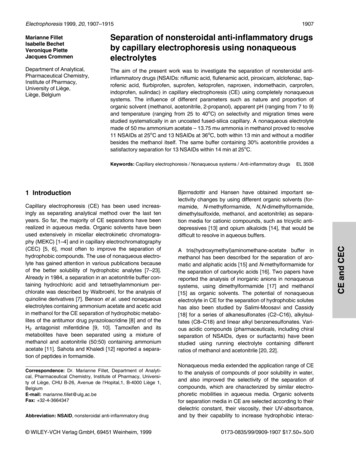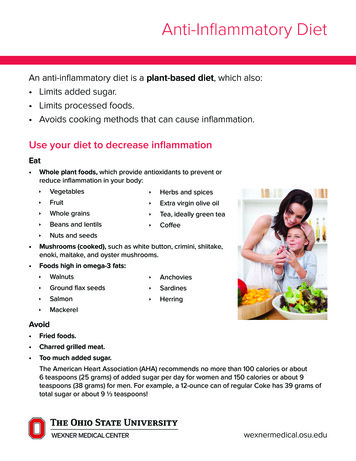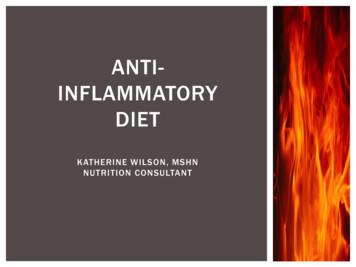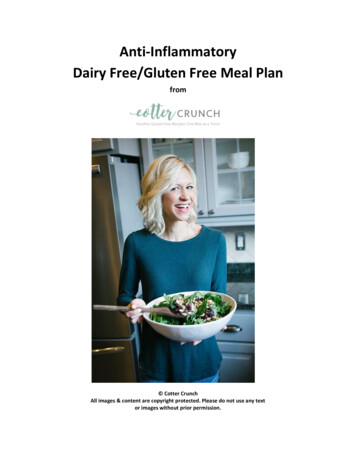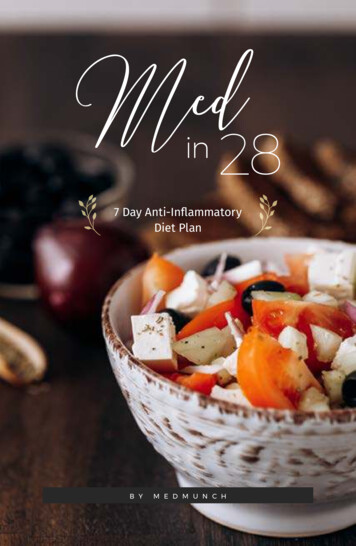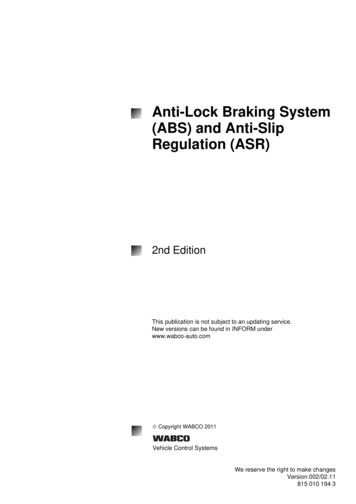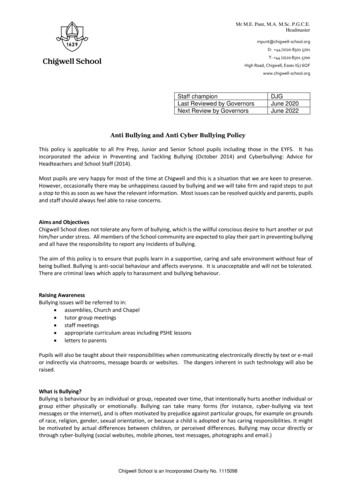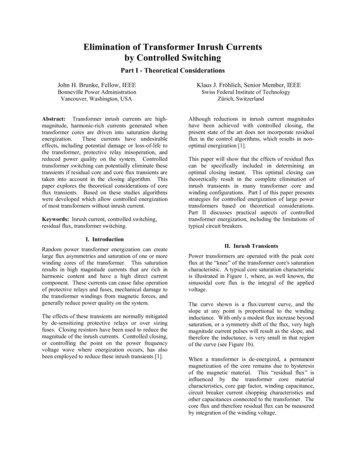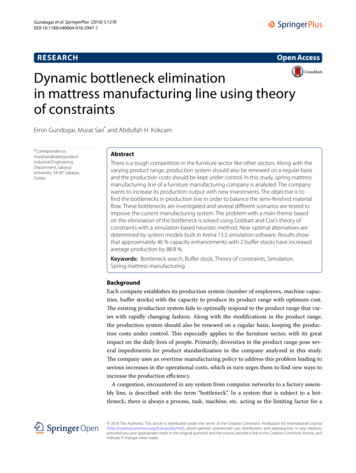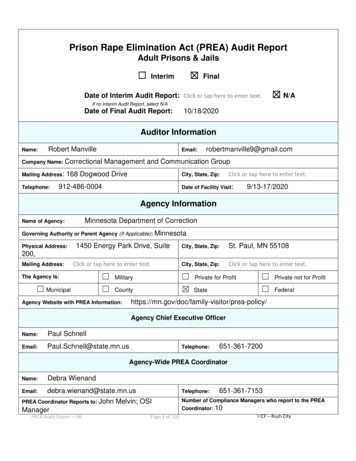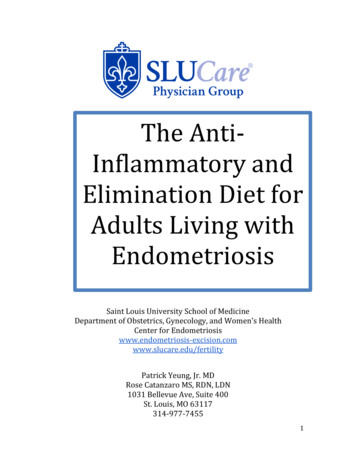
Transcription
The AntiInflammatory andElimination Diet forAdults Living withEndometriosisSaint Louis University School of MedicineDepartment of Obstetrics, Gynecology, and Women’s HealthCenter for care.edu/fertilityPatrick Yeung, Jr. MDRose Catanzaro MS, RDN, LDN1031 Bellevue Ave, Suite 400St. Louis, MO 63117314-977-74551
Table of ContentsOverview of Endometriosis .3-4What should your diet be composed of? .5Breakdown of Food Groups 6-8Organic or not? 9Hidden hormones in Your Food .10Which Fats are the Most Anti-inflammatory? .11Omegas by the Mouth .12Omega-3 Supplementation .13Elimination Diet and Endometriosis .14Implementing the Endo Elimination Diet .15-16Dairy Foods .17Gluten Foods 18-21Added Sugars 22The Basics of a Healthy Well Balanced Diet 25References 26-27Food Intake Log and Symptom Diary 282
Overview of EndometriosisEndometriosis is a painful, chronic disease where tissue that normallylines the uterus grows outside of the uterus. Such areas of growthinclude the abdomen on the ovaries and fallopian tube as well as thebladder, bowel, vagina, cervix, and the area between the vagina andrectum. The misplaced tissue builds up, breaks down, and sheds like thetissue that lines the uterus during menstrual cycles. However, themisplaced tissue has no way of exiting the body which results in internalbleeding, inflammation, bowel problems, infertility, scar tissueformation, and adhesions.Symptoms InfertilityFatiguePainful urination before periodsPainful bowel movements duringperiodsPain with sexPain before and during periodsdue to severe cramping, heavy menstrual flow, and periodslasting 7 daysDiarrheaConstipationNauseaPrevalenceAbout 1 in 10 women in the U.S. have endometriosis. About 176 millionwomen worldwide have endometriosis. Symptoms usually occur duringreproductive age (12-60 years old) but most women are oftenundiagnosed.Source: endofound.org3
Overview of EndometriosisCausesThere is no identified cause for endometriosis. Theories related togenetics suggest that it may be carried in genes so some families may bemore predisposed to it than others. Another theory has found it to bepresent at fetal development and activated during puberty. A retrogrademenstruation theory suggests that menstrual tissue can back up into thefallopian tube, implant in the abdomen, and grow which can lead to thedevelopment of endometriosis. Lastly, there has been a link between thebody’s inflammatory response and endometriosis but the mechanismbehind this theory is not well understood.TreatmentTo confirm diagnosis, a laparoscopy is performed which will show thelocation, size, and extent of the growths. The gold standard fortreatment is laparoscopic excision surgery to remove the growths.However, there is no cure for endometriosis.Source: endometriosisassn.org4
What should your diet be composed of?Alcohol,caffeine &sweets1-2 svg/weekLow-fat Dairy(Dairy-free ifnecessary)3 svg/dayWhole grains(Gluten-free ifnecessary)3-5 svg/dayHealthy cold-pressedoils (Extra virgin,canola flaxseed, nutbased oils),2-4 svg/dayFish,seafood3-5svg/weekVegetables4-5 svg/dayLean meat,poultry, eggs3-5 svg/weekNuts andseeds1-2 svg/dayBeans,legumes2-4svg/weekRed meat1-2svg/weekFruits1-2svg/day5
Vegetables: How much? 4-5 servings per day minimum (one serving 2 cups saladgreens, ½ cup vegetables cooked) Healthy Sources: Dark leafy greens (spinach, collard greens, kale,Swiss card), cruciferous vegetables (broccoli, cabbage, Brusselssprouts, bok choy, cauliflower), carrots, beets, onion, peas, squashes,washed raw salad greens Why? Vegetables are rich in flavonoids and carotenoids withantioxidant and anti-inflammatory properties. Aim for a plate that’scolorful in vegetables to get a wide variety of vitamins, including A, E,and C as studies have shown these vitamins to be lower inendometriosis patients.Fruits: How much? 1-2 servings per day (one serving 1 medium size pieceof fruit, ½ cup chopped fruit, ¼ cup dried fruit) Healthy Sources: Raspberries, blueberries, strawberries, peaches,nectarines, oranges, pink grapefruit, red grapes, plums, pomegranates,blackberries, cherries, apples, and pears all have lower glycemic index. Why? Fruits are rich in flavonoids and carotenoids with antioxidantand anti-inflammatory properties. Aim for variety in color to get a widevariety of nutrients, including A, E, and C.When possible, choose organic for reduced pesticide residue that havebeen associated with hormone imbalances.Fish and Seafood How much? 3-5 servings per week (one serving 4 oz. of fish orseafood) Healthy Sources: Wild Alaskan salmon, herring, sardines, and blackcod Why? Fish is rich in Omega-3s which are anti-inflammatory. Choosehigher fat, deep-sea fish as they have greater intakes of Omega-3s.Lean Meat, Poultry, Eggs How much? 3-5 servings per week (one serving 3 oz. of poultry orskinless meat) Healthy Sources: High quality skinless poultry, turkey, grass-fed leanmeats, free-range eggs Why? Lean meats are lower in saturated fat to better controlcholesterol levels.6
Beans and Legumes How much? 2-4 servings per week (one serving ½ cup cooked beansor legumes) Healthy Sources: Black beans, chickpeas, black-eyed peas, and lentils Why? Beans are rich in folic acid, magnesium, and potassium andsoluble fiber. They are a low-glycemic-load foods to stabilize bloodsugars.Red Meat How much? 1-2 servings per week (one serving 3 oz. of cookedmeat) Sources: Beef, steak, pork, veal Why? Limit these types of foods as red meats are shown to be proinflammatory and cause hormone imbalances. Choose grass-fed ororganic meats.Cold-Pressed Vegetable Oils How much? 2-4 servings a day (one serving 1 teaspoon of oil) Healthy Sources: Extra virgin olive oil, vegetable oil, canola oil,flaxseed oils, nut-based oils Why? Oils are high in Omega-3s and antioxidants which are antiinflammatory. They are also rich in monounsaturated fats that raisegood cholesterol (HDLs) and lower bad cholesterol (LDLs).Expelled cold-pressed oil is best since it is not chemically treated andheated at lower temperatures to extract the oil. When cooking with oil,use lower temperatures as higher temperatures increases theproduction of trans fat. Where to use? Drizzle cold-pressed oils on salads, over vegetables forroasting or sautéing, or even popcorn! Mix organic butter with a coldpressed oil for a healthier spread.Nuts and Seeds How much? 1-2 servings a day (one serving 2 walnuts, 1tablespoon of flaxseed, 1 oz. of avocado, 1 tbsp. of peanut butter) Healthy Sources: Almonds, walnuts, ground flaxseed, pecans, hempseeds, avocado, natural peanut butter, chia seeds Why? Nuts and seeds are high in Omega-3s which are antiinflammatory. They are excellent sources of B-vitamins in addition tophosphorous.7
Whole Grains How much? 3-5 servings a day (one serving ½ cup cooked grains) Healthy Sources: Brown rice, basmati rice, wild rice, buckwheat,quinoa, steel-cut oats, gluten-free noodles or pasta Why? Whole grains have added B-vitamins with added fiber topromote a healthy digestive tract and reduce spikes in blood sugar thatpromote inflammation.Low-fat Dairy or Dairy Alternatives How much? 3 servings a day (1 ounce of cheese, 8 ounce serving ofmilk/dairy-free milk, 1 cup of yogurt) Healthy Sources: Low-fat cheeses (Swiss, mozzarella, parmesan), fatfree yogurt, cottage cheese, skim or 1% milk. You can find dairy-freeoptions of these foods as healthy dairy alternatives. Why? Vitamin D has been shown to reduce pro-inflammatorycytokines that contribute to possible inflammation associated withendometriosis. Choose organic dairy products to reduce the amount ofhormones added to your foods.Alcohol, Caffeine, Processed Foods, and Sweets How much? 1-2 servings per week, sparingly Sources: Processed foods, fried foods, fast-food, caffeine in sodas orsugary sweetened beverages, alcohol Why? These types of foods have no nutritional value and added sugarwhich can prevent other vital nutrients from being absorbed. Caffeineand alcohol have been thought to impair ovarian function, aggravatePMS symptoms, and negatively affect infertility. Sweets are proinflammatory and should be limited. What to eat instead? Healthier sweet substitutes can include smallservings of dark chocolate, dried fruit, frozen yogurt, and fruit sorbet.Water How much? 8-8 oz. glasses of water, half a gallon (64 oz.) Sources: Pure water, or drinks that are mostly water, such as tea orsparkling water with lemon. Why? Water is vital for overall proper functioning of the body andremoves metabolic waste products.8
Organic or not?Research has shown that pesticides like organochlorines,organophosphates, bipyridines have been associated withdecreased antioxidant capacity of fruits and vegetables. Inaddition, organochlorines have been shown to negatively affecthormonal pathways.VS.Foods on the “Dirty Dozen” list have the greatest amount ofpesticides while foods on the “Clean Fifteen” list have the leastamount. In order to consume a wide variety of fruits andvegetables for optimal nutrition, choose organic produce whenpurchasing fruits and vegetables from the Dirty Dozen list toreduce pesticide exposure.9
Hidden Hormones in Your FoodDairy and meat products have added hormones that may be linked withhormone imbalances in patients with endometriosis. However, thenutrients from these foods, such as protein, Vitamin D, calcium, and ironare important components of a well-balanced diet.To reduce the amount of hormones in your foods, choose organic milkor dairy-free milk and grass-fed beef.What constitutes organic?Below are the USDA organicregulations:Managed without antibiotics, addedgrowth hormones, mammalian oravian byproducts, or other prohibitedfeed ingredients (e.g., urea, manure,or arsenic compounds)Livestock that is allowed year-roundaccess to the outdoors for grazingRaised on certified organic landFed 100% certified organic feedManaged in a way that conservesnatural resources and biodiversity10
Which fats are the most anti-inflammatory?Flaxseed has the highest Omega-3 concentration followed bycanola and soybean oil.The goal is to consume and use fats that have lower saturatedfat and a higher Omega-3 to Omega-6 ratio to reduce rates ofinflammation associated with endometriosis.11
Omegas by the MouthfulCheck out the foods listed below to see which are the bestsources of Omega-3s to help reduce inflammation.Salmon, Atlantic, farmedAssorted Fish and SeafoodSalmon, Chinook, cookedMackeral, AtlanticOmega 6Salmon, Atlantic, wildShrimpOmega 3DHA orEPATuna, blue finTuna, yellow finCod, pacificLobsterFlounder or sole0%50%100%Percentage of Omega-6s vs. Omega-3sFoods with a longer red line have larger amounts of Omega-3s.Assorted Meat & Protein FoodsBeef, lean, grain-fedChicken, dark met, with skinEgg YolkOmega 6Egg WhiteBaconOmega 3DHA or EPAChicken, white meat, skinlessBeef, grass fed, leanLamb, high fatVenisonLamb, lean0%50%100%Percentage of Omega-6s vs. Omega-3sFish has a greater amount of Omega-3s compared to other sources ofmeat. The goal is to consume a variety of seafood and add in lean lamb,grass-fed beef, and skinless white meat chicken as good protein sourceswith larger amounts of Omega-3s and lower fat intake.12
Most expensiveOmega 3 SupplementationPast research has shown that Omega 3 supplementation in theform of EPA & DHA can improve rates of fertility and reduceoxidative stress as a cause of inflammation.Omega-3 supplementation is increasingly being prescribed to patientswith endometriosis. Discuss with your doctor if this is right for you.A feasibility study was conducted on different fish oil supplements tocompare their costs and benefits. The ProOmega liquid form is thebest deal as it will last the longest for a total of 48 days compared to theothers that range from 20-30 days.13
Elimination Diet and EndometriosisTo help manage painful symptoms like abdominal pain, nausea, andcramping that can be associated with endometriosis, certain foods canbe eliminated from the diet that worsen these symptoms. Research hasshown that a gluten free diet can lead to dramatic pelvic pain reductionin women suffering with endometriosis. These may include:1. Dairy contains a sugar called lactose that may be difficult for somewomen to breakdown and digest, causing cramping, diarrhea, and pain.2. Gluten is a protein found in grains and wheat products which hasbeen shown to cause diarrhea, abdominal pain, and bloating in womenwith gluten sensitivity. Gluten can cause malabsorption of vitamins andminerals that regulate hormones. Gluten, also can cause inflammationand induce autoimmune reactions that attack hormones and hormonereceptors.3. Added sugars in processed foods, such as packaged or preparedfoods, soft drinks and baked goods, can increase inflammation.If you experience any of these symptoms, you may be agreat candidate for the Endo Elimination Diet. Discuss withyour doctor and dietitian to make the best plan for yourhealth moving forward.14
The Endo Elimination DietThe goal of an elimination diet is to remove all foods that could belinked to making your symptoms worse. There are two phases in anelimination diet.1. Phase 1- Elimination: Over the course of 2 weeks, you willremove all dairy, gluten, and added sugars and consume only thefoods approved on pages 4-5.2. Phase 2 – Challenge: Over the course of 4 weeks, you will slowlyreintroduce these foods back into the diet. You will track yoursymptoms and discuss them with your doctor and dietitian to seewhich foods your body can tolerate.How to be successful at following this diet?1. Learn more about endometriosis before starting the Endo Diet.These books have been recommended by the Endometriosis Associationas great reads to provide a more comprehensive overview ofendometriosis. Endometriosis: The Compete Reference for Taking Charge of YourHealth by Mary Lou Ballweg and Endometriosis Association Endometriosis: A Key to Healing Through Nutrition by DianShepperson Mills, M.A., and Michael Vernon, Ph.D, HCLD The Endometriosis Sourcebook: The Definitive Guide to CurrentTreatment Options, the Latest Research, Common Myths aboutthe Disease, and Coping Strategies-both Physical and Emotionalby Mary Lou Ballweg and Endometriosis AssociationAdditional reference: The Anti-Inflammation Diet and Recipe Book by Jessica K. Black15
2. Record your current symptoms before starting the eliminationdiet. This is an essential step to help you identify what changes occur inyour symptoms when eliminating foods from your diet. Have anotebook handy to write the symptoms. Keep this notebook with you atall times when eating to record how you react to certain foods, before,during, and after the elimination diet. This will help the doctor anddietitian better determine what the cause of your GI symptoms. Plan your meals. Following the Endo Elimination diet can bedifficult because you are eliminating foods that might be staplesin your everyday diet. Therefore, plan your meals ahead of timeto ensure that you can successfully follow the diet. Go groceryshopping and purchase foods on the approved foods list beforestarting your diet. Try out these food blogs for fresh, innovativeEndo diet recipes to get you started!o Foodie 4 Healingo ENDODIETo Jessica Murnane Jump right in! Follow the elimination phase for 2 weeks eatingonly the foods from the approved food lists. (See EndometriosisFood and Symptom Diary at the end of this booklet)16
Dairy FoodsDairy Foods to AvoidDairy-free Alternatives to ConsumeCow’s milkAlmond, coconut, soy, lactose-free milksYogurt (all types)Cheese (all types)Lactose-free yogurtDairy-free cheese, nutritional yeastCottage cheeseSour creamDairy-free cottage cheeseSoy sour cream, nutty sour creamButterMargarineCondensed milkOlive oil, vegetable oil, canola oil, nut oils,etc.Dairy-free margarineCream of coconut, dairy free milk powderCream cheeseCoconut cream, low fat soy creamCoffee creamersDairy-free coffee creamers, soy creamersIce creamWhipped creamChocolateDairy-free ice creamLow fat soy creamBaking chips and bars from dairy-freebrands like Enjoy Life Foods, PaschaOrganic Chocolate, Taza Chocolate,Scharffen Berger Baking ChocolateFor more recipes, grocery lists, and helpful tips on going dairyfree, visit godairyfree.org!17
Gluten foods to Avoid on Elimination DietFoods with Gluten to AvoidGluten-free Foods to ConsumePastas (raviolis, dumplings, couscous,gnocchi)Noodles (ramen, udon, soba, chow mein,egg noodles)Gluten-free pastaRice, cassava, quinoa, millet,arrowroot, amaranth, teff,amaranthBreads and pasteries (croissants, pita, naan, Gluten-free breads, bagels,bagels, flatbreads, cornbread, potato bread, muffins, rollsmuffins, donuts, rolls)Crackers (pretzels, goldfish, grahamGluten-free crackerscrackers)Baked goods (cakes, cookies, pie crusts,Gluten-free pastriesbrownies)Cereal and granola (corn flakes, rice puffs,Gluten-free cerealsoats)Breakfast foods (pancakes, waffles, French Gluten-free pancakes, wafflestoast, crepes, biscuits)OatmealGluten-free oatsBreading and coating mixes (pankoBreading made with ground upbreadcrumbs)flax or chia seedsCroutons (stuffing, dressings)Dressings made with flax or chiaseedsSauces and gravies (soy sauce, creamSauces made with rice, soy, corn,sauces)potato, or bean floursFlour tortillasGluten-free tortillasBeer, malt beveragesGluten-free beersWheat flour as an ingredient, “wheat free”Nut flours, gluten-free floursdoes not mean gluten free(rice, soy, corn, potato, bean)For more recipes, grocery lists, and tips to eating gluten-free,visit glutenfreeliving.com!18
Watch out for Hidden Gluten!Some foods may contain hidden gluten.These may include: Energy bars/granola bars – some bars may contain wheatas an ingredient, and most use oats that are not glutenfree French fries – be careful of batter containing wheat flouror cross-contamination from fryers Potato chips – some potato chip seasonings may containmalt vinegar or wheat starch Processed lunch meats Candy and candy bars Soup – pay special attention to cream-based soups, whichhave flour as a thickener. Many soups also contain barley Multi-grain or “artisan” tortilla chips or tortillas that arenot entirely corn-based may contain a wheat-basedingredient Salad dressings and marinades – may contain maltvinegar, soy sauce, flour Brown rice syrup – may be made with barley enzymes Meat substitutes made with seitan (wheat gluten) such asvegetarian burgers, vegetarian sausage, imitation bacon,imitation seafood (Note: tofu is gluten-free, but becautious of soy sauce marinades and cross-contaminationwhen eating out, especially when the tofu is fried) Soy sauce Self-basting poultry Pre-seasoned meats Cheesecake filling – some recipes include wheat flour Eggs served at restaurants – some restaurants putpancake batter in their scrambled eggs and omelets, buton their own, eggs are naturally gluten-free.19
Watch out for Hidden Gluten!Some products may contain hidden gluten. These include: Lipstick, lipgloss, lipbalmHerb or nutritional supplementsDrugs, over-the-counter medicationsVitamin and mineral supplementsLotions, moisturizersShampoosToothpasteThe following ingredients are often code for gluten: Avena sativa CyclodextrinDextrinFermented grain extractHordeum distichonHordeum vulgareHydrolysateHydrolyzed malt extractHydrolyzed vegetable proteinMaltodextrin Phytosphingosine extractSamino peptide complexSecale cerealeTriticum aestivumTriticum vulgareTocopherol/vitamin E Yeast extractNatural flavoring, caramel colorBrown rice syrupModified food starchHydrolyzed vegetable protein (HVP)Hydrolyzed soy protein20
Read Your Labels for Gluten!To make sure you are not accidently ingesting gluten, be sureto read the label on all your food products before purchasing.Look for the words “wheat, barley, rye and oats” to identify if afood contains gluten.If in doubt about a food, go without consuming it just to besure!21
Added Sugar Foods to Avoid on EliminationDietAdded Sugar Foods to AvoidRegular soft drinks, energy drinks, andsports drinksJuice, fruit punchCandy, cakes, cookies, pies, cobblersSweet rolls, pastries, and donutsDairy desserts, such as ice creamFoods to ConsumeUnsweetened tea, Crystal Light,water100% freshly squeezed juiceSugar-free cookies, candySugar-free rollsFrozen yogurt, plain GreekyogurtReading the label on processed foods can help identify addedsugars. The different names for sugar include: Anhydrous dextroseBrown sugarConfectioner's powdered sugarCorn syrupDextroseFructoseHigh-fructose corn syrup (HFCS)HoneyInvert sugarLactoseMalt syrupMaltoseMaple syrupMolassesNectars (e.g., peach nectar, pearnectar) Raw sugar Sucrose White granulated sugar22
The Challenge PhaseDuring this phase, you will introduce one challenge food at atime. Start with small portions on the first day of the challengeand record any symptoms in your notebook. The challengephase will last 3-4 weeks, depending on the severity of yoursymptoms.Week 1: Dairy Challenge Day 1: Smaller portions Day 2: Larger portions Record in journalWeek 2: Gluten Challenge Day 1: Smaller portions Day 2: Larger portions Record in journalWeek 3: Added Sugar Challenge Day 1: Smaller portions Day 2: Larger portions Record in journal23
Now what?Interpret your results: Look at the symptomsrecorded in your journal. What foods triggered yoursymptoms and in what amounts? What foods were safefor you to eat? Discuss with your dietitian about how toevaluate your symptoms moving forward.Change your diet: Avoid foods that trigger yoursymptoms during the challenge phases. Focus onconsuming a well balanced diet without triggering yoursymptoms.24
The Basics of a Healthy, Well Balanced DietSince there is no specified cause for endometriosis, it isimportant to adhere to a diet that focuses on variety andbalance for optimal nutrition. The focus should be onconsuming a diet balanced in all five groups, including fruits,vegetables, dairy, protein, and grains. Aim for half of your plate to be filled with a variety ofcolorful fruits and vegetables. These are high in vitaminsand antioxidants to reduce inflammation. Make half your grains whole grains. Vary your protein by adding in plant-based protein likebeans and legumes to lower red meat consumption. Look for food and drink sources that are lower insaturated fat, sodium, and added sugars. Choose low-fat or fat-free dairy. Incorporate healthy fats like Omega 3’s found in avocado,fish, nuts, and olive oil to reduce inflammation. Get active at least 30 minutes a day which has beenshown to reduce ovarian stimulation and estrogenproduction.25
References/WebsitesEndometriosis (2016). Retrieved from:www.endometriosisassn.org/endo.htmlWhat is Endometriosis? (2016). Retrieved from:www.endofound.org/endometriosisEndometriosis Foundation for America (2016). AboutEndometriosis. Retrieved from: www.endofound.orgEndoOnline (2015). What is it? Retrieved from:www.endometriosisassn.org/MyPlate (2016). Retrieved from: www.choosemyplate.gov/MyPlateMyPyramid (2005). Retrieved from:www.cnpp.usda.gov/mypyramidSaint Louis University Center for Endometriosiswww.endometriosis-excision.comGluten and Endometriosis (2016). Retrieved iosis-is-there-aconnection/Sources of Gluten (2016). Retrieved t/sources-of-gluten/Organic.org (2016). “The Dirty Dozen.” Retrieved 214USDA. (2016). Organic Agriculture. Retrieved idonly true&contentid organic-agriculture.html26
References/ WebsitesWeil, Dr (2015). Anti-Inflammatory Diet. Retrieved ry-dietHalpern, G., Schor, E., & Kopelman, A. (2015). Nutritional aspectsrelated to endometriosis. Revista Da Associação Médica Brasileira(1992), 61(6), 519-523. doi:10.1590/1806-9282.61.06.519Marziali, M., Venza, M., Lazzaro, S., Lazzaro, A., Micossi, C., & Stolfi,V. M. Gluten-free diet: a new strategy for management of painfulendometriosis related symptoms? Minerva Chirurgica (2012), 67(6), 499-504.Parazzini, F., Viganò, P., Candiani, M., & Fedele, L. (2013). Diet andendometriosis risk: a literature review. Reproductive BiomedicineOnline,26(4), 323-336. doi:10.1016/j.rbmo.2012.12.011Qu X, Li S, Wang Z, Li M. Maternal insulin resistance causesoxidative stress and mitochondrial dysfunction in mouse oocytes(2012). Human Reproduction 27 (7):2130-2145.doi:10.1093/humrep/des137Shepperson, D., Vernon, M (2002). A Key to Healing and Fertilitythrough Nutrition.A special thank you to Anne Cameron MS, RDN for herdedication and assistance in development of this booklet.27
28
free yogurt, cottage cheese, skim or 1% milk. You can find dairy-free options of these foods as healthy dairy alternatives. Why? Vitamin D has been shown to reduce pro-inflammatory cytokines that contribute to possible inflammation associated with endometriosis. Choose organic dairy produ
